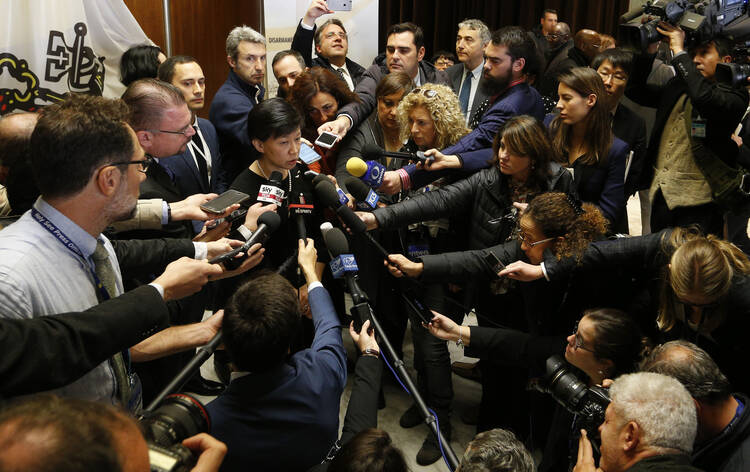If Jesus is the mediator between God and humanity, what can the news media learn from his example?
Here are a few ideas from theologians of the mid-century ressourcement movement that was influential at the Second Vatican Counci and from their contemporaries in media theory.
Uniting
First, Jesus united people by communicating—literally, “making common” to everyone—salvation. The Jesuit theologian Henri de Lubac writes in Catholicism: Christ and the Common Destiny of Man that humanity was divided by original sin but that Christ united us, making us all one body. Even when Jesus says he came to bring division, not peace (Lk 12:51), theologian Hans Urs von Balthasar explains, this “division” refers to God’s judgment of us when we die, which happens in the context of our love relationship with God. In that love relationship, we remain united as brothers and sisters in Christ.
Likewise, though to a lesser degree, the media has the power to unite people by giving them shared experiences, like the bond between people who love the same movies or who watch the same sports games. This ability to bring people together was outlined by communication theorists Pierre Bourdieu, Harold Lasswell and the trio of Elihu Katz, Michael Gurevitch and Hadassah Haas. But it is not all fun and games: The ability to bring people together must not be used to incite a “mob mentality.”
The ability to bring people together must not be used to incite a “mob mentality.”
Instead, the post-Vatican II document “Communio et Progressio”says that the media should help the public form sound opinions by providing them with a wide variety of views on a subject to help them discern what is right.
Inspiring audiences to look deeper and act for justice
Jesus also trusted his audience to draw meaningful conclusions from what he said. The Jesuit theologian Cardinal Avery Dulles calls this “symbolic communication” because, like symbols, Jesus’ parables inspire his audience to look beyond the surface meaning.
Journalists can do this, too, by inspiring their audiences to look deeper into social issues and explore the broader context of the stories we report, while maintaining the objectivity that makes us credible. We can do this, for example, by providing historical background about the issues we are covering, including links for further reading, and by telling the stories of underrepresented people who audiences can connect with and care about.
Ultimately, as “Communio et Progressio”says and as history teaches us, at its best our work as journalists can and does inspire people to act for justice.
Transparency
Finally, Jesus’ example can teach us how to combat “fake news.” Many people know of Marshall McLuhan’s famous theory of communication: “The medium is the message.” Mr. McLuhan followed up on his theory a few years later, saying that Jesus is the one example in which the medium and the message are fully one and the same: Jesus transparently communicates who God is because he is God.
Journalists obviously cannot achieve this level of medium-as-message, but we should try to be as transparent as possible in our work. This can be as simple as citing all our sources and being honest about where we found our information, or it can be more complex, like examining our internal biases or learning about the way we frame and “code” information, as theorists Claude Shannon and Warren Weaver outlined in their famous model of communication.
In the end, taking a hard look at our own biases and learning to communicate transparently will build our credibility as journalists, making it easier for us to help audiences form sound opinions and look more deeply into the world’s problems, thus bringing people together in relationships of empathy and a shared desire for justice. As “Communio et Progressio” says, the media’s purpose is “to accelerate every sort of human progress and to increase cooperation among [all people] until there exists a genuine communion among them.”











If only they would but as we too often see:
Too much of current journalism is written from a point of view that reflects the bias of the reporter/publisher and limits sources and opinions to a narrow range supporting that bias. This produces not necessarily fake news but a fake or false narrative. It seems to be the norm today. Good journalism is the exception.
The problem is often the reader who comes to a news source wanting to see news/opinions that support their own biases. President Trump as been a bonanza for several media sources as they have new subscribers or viewers who expect a Trump bashing every day. The news sources have responded with news/opinions that reward these new subscribers/viewers. Readers of the Ny Times thrstened to cancel their subscriptions when a very conservative editorial appeared.
Similarly, conservative sites produce a host of pro-Trump articles and broadcasts every day in order to gain readers/viewers after producing anti-Obama articles for the last 8 years.
If you want to see how different people see the news, bookmark ABCnews, Wall Street Journal, CNN, Google News, MSNBC and Foxnews. It will be an eye opener as one sees what is featured for each's viewers. I just accessed each and saw no commonality between any of these sites which means the news is skewed. My guess is the narrative of whatever stories they have in common will also be skewed. This means the average reader has to read several sources to really understand the news.
Funny you should mention this. Fordham is hosting Dan Rather, one of the greatest perpetrator of "fake news" in recent memory, February 15, 2018. Rather was unclothed by an analyst who analyzed the "type" used in forging a document regarding George Bush's military service. Sorry, Dan, that Selectric typeface on the spinning round ball wasn't available at the time. Rather fell into the trap of projecting his personally biased view into his "reportage".
How many people recall Walter Cronkite's declaration of the Tet Offensive as a loss for American military forces? This too was a lie.
Some in the media still believe that George H.W. Bush flew in a SR-71 Blackbird, met with the Iranians, and colluded with them to steal the 1980 election. Funny isn't it how "collusion" seems to be a part of every major dem presidential loss.